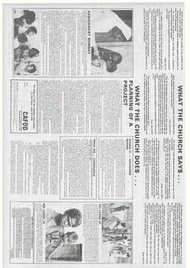Page 4, 24th September 1976
Page 4

Report an error
Noticed an error on this page?If you've noticed an error in this article please click here to report it.
Tags
Share
Related articles
Two-way Problem
Church V. State In U.s. School Crisis
New Records Set Up In Building
No 'back Door' For Catholic Pupils, Insists Ces
Changes In Birth-rate May Affect Schools
The facts and figures of Catholic education
SINCE the war the Catholic school system has expanded greatly under the impulse of a high birthrate. Numbers of pupils in Catholic schools have increased from about 550,000 in 1950 to more than 900,000. The secondary school system increased particularly, as secondary schools replaced the senior departments of all-age or elementary schools. The fall in the birthrate is halting expansion in most areas (in some developing areas numbers are still going up). Numbers in primary schools have already dropped nationally and numbers in secondary schools are at their peak but will fall.
Teacher training, which expanded greatly in the 1950s and 1960s, has already had to contract because of reduced demand for teachers. In most areas now the number of Catholic schools is sufficient to meet the actual demand from parents. There remain some areas with a shortage, and for some parents in areas where schools are available the cost of transport is a serious obstacle to their children's attendance at Catholic schools.
Changes of recent years include the gradual move to comprehensive education. More than half the children at Catholic aided secondary schools are at comprehensive schools of one kind or another, and the number is increasing. Nursery provision is developing in Catholic primary schools and its amount is expected to increase gradually.
Successive increases over the years in the grant rate for aided school building (from 50 per cent for certain kinds of work to 85 per cent for all kinds of work) have made it possible for school building to continue and have prevented the cost to the Church becoming out of all possibility. At present the annual cost to the Catholic community runs between £5m and £6m a year. It is difficult to estimate this figure precisely because it is made up of the costs of insurance, the 15 per cent that the Church has to find of the building and repair costs, and of course the repayment of loans and interest on them.
Although there is less building being carried out now than previously because of high interest rates, the overall figure has risen slightly recently. There are three different types of Catholic school: Voluntary Aided Schools — Two-thirds of the manag ing and governing body of these schools are appointed from the Church (voluntary) side, one-third by the local authority. Managers or governors appoint the teachers, control religious education and control admissions. The Church or other trustees own the school. The school's running costs are met by the local authority. Voluntary responsibility is confined to the provision of buildings and external repairs with government grants, recently raised to 85 per cent.
Direct-grant Schools — The governing body is composed in a similar way to aided schools and controls the work of the school. The grant per pupil from the Government covers currently about 25 per cent of the costs, and the remainder comes from fees which may be paid by the local authority.
In Catholic schools it is normal for a high proportion of places to be taken by local authorities, who then pay the fees. In recent years capital expenditure has been financed mostly from fees, with voluntary contribution usually similar to that required at the time in aided schools. Direct-grant schools are being phased out and Catholic direct-grant schools will mostly become aided.
Independent Schools — These are controlled by their own governing bodies and financed by fees. At Ampleforth, for example, these are £620 a year. Local authorities may pay the fees, and in cases of Catholic schools have often done so on a significant scale where Catholic aided schools were not available.
blog comments powered by Disqus











